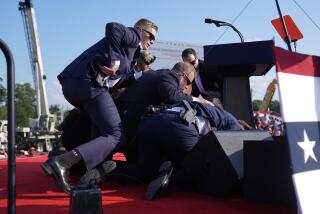President’s Chef Gets Grilled by Overzealous KGB Guards : Security: The threat of burning chicken finally gets him past security and into the ambassador’s kitchen. But the rest of the city seems nonchalant about Bush’s visit.
- Share via
MOSCOW — In a fit of pre-summit overzealousness, Soviet KGB guards Monday blocked the White House chef as he tried to enter the palatial U.S. ambassador’s residence to chop vegetables.
After several minutes of chatter on walkie-talkies and loud protests from four U.S. Navy stewards, who accompanied the chef and who said that chickens in the ambassador’s kitchen were in danger of burning, the KGB honcho on the scene cleared the staff of the White House mess to pass.
“Sure, there are inconveniences,” the White House’s disgruntled executive chef, Hans F. Raffert, said as he stood at a police barricade trying to persuade the guards to let him in. “But overall, its very interesting to be here. It’s the first time I’ve traveled with the President.”
Raffert, a White House chef for 22 years, had left the ambassador’s residence earlier in the day, then--still attired in full chef’s regalia--returned to find a phalanx of KGB guards outside. He had flown ahead of President Bush with a planeload of groceries and California wines to begin planning a feast for Wednesday evening, when the Bushes entertain President Mikhail S. Gorbachev and his wife at a state dinner at Spaso House, the ambassador’s residence.
On the menu will be watercress soup, roast tenderloin of veal with truffle sauce, tiny oven-roasted potatoes, green beans and baby carrots, mixed green salad, Brie cheese and vodka sherbet with fresh raspberries--and Raffert wanted to get a head start on it Monday.
The elegant Spaso House, an 18th-Century mansion on a quiet side street about a mile from the Kremlin, has been the residence of U.S. ambassadors since 1933, when diplomatic relations between the United States and the Soviet Union were established.
Despite tight security at the ambassador’s residence, where the President and Mrs. Bush are staying during the summit meeting, the rest of Moscow seemed nonchalant about the visit of the American President, with only a few last-minute preparations under way.
Just hours before Air Force One landed, the parking lots were being repaved at the International Trade Center, site of a summit press center set up by the Soviet and American governments, but the Soviet capital had not received the face-lift it used to get for important visitors.
Before past Soviet-American summits, in what became a virtual tradition, Moscow streets were repaved, buildings got fresh coats of paint, trees and shrubs were planted and drunks and vagrants were rounded up and dropped 60 miles outside the city.
And when the U.S. President arrived in those days, his route from the airport was lined with cheering Soviet well-wishers.
This pokazukha, or “false show”--the Russian expression for putting up a false front--has disappeared with the advent of President Gorbachev’s reforms and the collapse of the Soviet economy.
“The situation has changed,” said Oleg I. Orlov, press spokesman for Moscow Mayor Gavriil Popov. “What we called pokazukha is a thing of the past. Gone are the days when the city was all cleaned up and people were forced to line Leningradsky Prospect to greet visiting dignitaries.”
But the scene is quite different at the U.S. Embassy, where the staff has been working nearly 24 hours a day to get ready for the visit of the President--and his accompanying delegation of nearly 600 officials and staffers--in record time since the summit date was set less than two weeks ago.
“We’re short on supplies--office supplies, Xerox machines, everything,” said Jack Harrod, head of the U.S. Information Service’s booth at the summit press center. “One of the problems is that it was organized at such a late date. In 1988, when President Reagan visited, there were several months to prepare.”
But some embassy officials were glad that they have not had the summit meeting hanging over their heads for months.
“It’s actually a blessing that we’ve only had 10 days to prepare,” said John Ohta, the embassy press attache. “We’ve done what we normally do, but a lot quicker.”
Despite the short notice, security is extensive. More than 1,000 officers from the KGB, the Soviet security and intelligence agency, and the Moscow police force are involved in security for the summit, KGB Col. Valery Velichko told the official news agency Tass.
U.S. Secret Service agents, carrying their guns just as KGB agents do when Gorbachev goes to Washington, have been working in harmony with their Soviet counterparts, Velichko said.
“Our service and the American service apply identical approaches to our duties protecting the presidents,” Velichko added. “Our service naturally gives priority to security but at the same time tries to ensure maximally normal conditions for reporters.”
Most of the thousands of foreign reporters in Moscow will get nowhere close to the two presidents, but journalists working at the press center can watch live television coverage of much of what is happening.
Although Moscow street peddlers have not yet caught on to the commercial opportunities of a summit, cartoonists on Moscow’s pedestrian mall, the Arbat, rose to the occasion. On the days leading up to the visit, caricatures of George and Barbara Bush hung alongside those of Mikhail and Raisa Gorbachev.
“The portraits of Bush are selling fastest,” cartoonist Andrei V. Karabashky said. “Our whole country loves Bush, and that’s a lot more than we can say about Gorbachev.”
More to Read
Sign up for Essential California
The most important California stories and recommendations in your inbox every morning.
You may occasionally receive promotional content from the Los Angeles Times.













